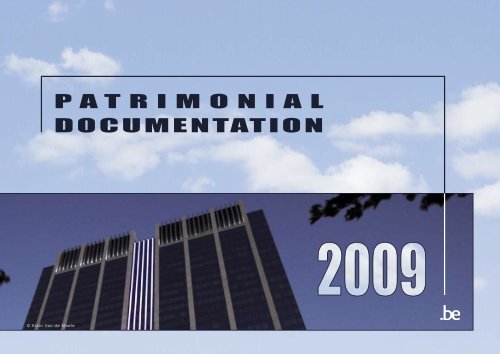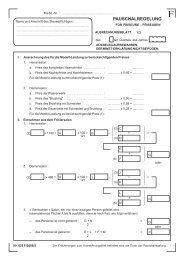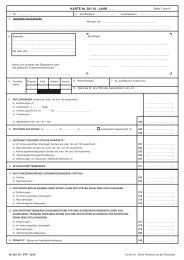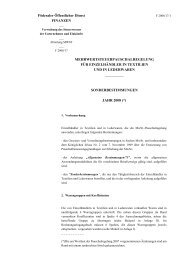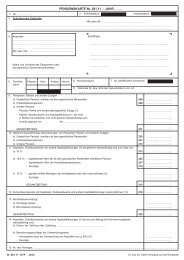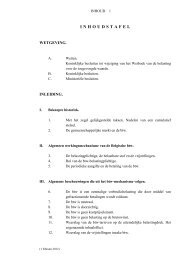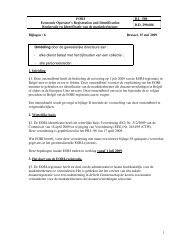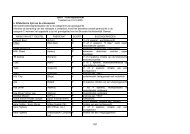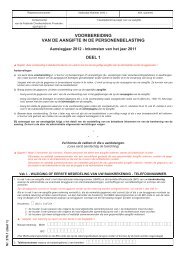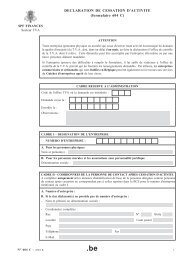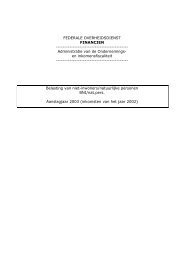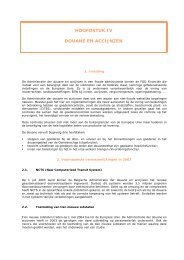DOCUMENTATION PATRIMONIAL - Fiscus.fgov.be
DOCUMENTATION PATRIMONIAL - Fiscus.fgov.be
DOCUMENTATION PATRIMONIAL - Fiscus.fgov.be
You also want an ePaper? Increase the reach of your titles
YUMPU automatically turns print PDFs into web optimized ePapers that Google loves.
© Alain Van de Maele<br />
P A T R I M O N I A L<br />
<strong>DOCUMENTATION</strong>
Brasschaat © REgie der gebouwen
Foreword<br />
<br />
The reform within the FPS Finance, known as Coperfin, which started many years ago continues its<br />
inevitable way. The Patrimonial Documentation is thoroughly reorganized, it introduces new work<br />
methods and <strong>be</strong>comes familiar with new computer tools. It is a long-winded work but at which price?<br />
Our Administration has about 6.000 staff mem<strong>be</strong>rs. Most of them work in decentralized operational<br />
services. Needless to say that they are the ones who daily experience on the field, at close quarters, the<br />
modernization and all its radical changes; I would even state that they are the heart of our organization<br />
and that it is essential, after this time which seems endless, to feel the pulse of the organization! So, it is<br />
their point of view, their critical voice, which can <strong>be</strong> heard in the pages of this report. It is all balanced<br />
of course and always with a certain reserve which is necessary towards an authority. However, bitterness<br />
and disillusion appear, <strong>be</strong>tween the lines, as well as a lot of goodwill. It is clear that the reduction of the<br />
staff was cruelly felt and the new tools, which were expected, were delayed. A modernization, yes of<br />
course, but awaiting the installation of the whole technology which goes together with it, it is essential to<br />
assure the daily work with the available means and to provide to the citizens the service they require. That<br />
is, exactly and rightly, one of the main motives of all these changes. And if, internally, the organization<br />
suffers, the citizen as for him, must indisputably appreciate the new attitude that has control over all our<br />
actions. So, I am particularly proud to notice that the civil servants of the Patrimonial Documentation<br />
consider it more than ever an honour to accomplish conscientiously their tasks, despite the discomfort of<br />
a reform which is not completely finished. Besides, I seized the opportunity of this forum to thank them, to<br />
say that I understood their requests and also to assure them of my complete support. Among these pages,<br />
illustrated by various buildings which house our services, you will discover their opinions, and the results<br />
of their work through our statistics.<br />
Enjoy your reading,<br />
Daniel De Brone<br />
General Administrator
The General Administration of the Patrimonial Documentation<br />
General Administrator<br />
Services of the<br />
general Administrator<br />
Staff departments<br />
operational Expertise<br />
& support<br />
operational<br />
Coordination and<br />
communication<br />
Administrations<br />
Surveys &<br />
Valuations<br />
Legal<br />
Security<br />
patrimonial<br />
departments<br />
Collection &<br />
Exchange of<br />
information<br />
non-fiscal<br />
Recovery<br />
operational Services<br />
SECAL
The Branches, new administrative districts<br />
<br />
Introduction The central idea: rationalizing The first steps<br />
When it started in 2001, the Coperfin reform<br />
showed a great ambition: modernizing the<br />
Ministry of Finance! And there also was the<br />
will to improve and rationalize the working of<br />
the services and to guarantee irreproachable<br />
service performances to private persons and to<br />
professionals.<br />
For the former Administration of Land Register,<br />
Registry and Public Property, the fundamental<br />
change started with a new name and a revision<br />
of the structure. So, welcome to the General Administration<br />
of the Patrimonial Documentation<br />
which has today five Administrations. ■<br />
In 2004 the notion of branch appeared as the<br />
definition given to the new administrative districts,<br />
at the same time as the stipulations related<br />
to the new working methods. So, exit the Registry<br />
or Control offices of the Land Register: from<br />
now on these operational services specialize<br />
themselves within the branches of the Legal Security<br />
or the branches of Surveys & Valuations.<br />
Redistributing the competences, adapting the<br />
working methods, merging the districts, these<br />
are the objectives to <strong>be</strong> reached in order to improve<br />
the productivity, to specialize the tasks and<br />
to guarantee a continuous service performance<br />
while the Administration constantly experiences<br />
the repercussion of the decrease of staff and the<br />
recurrent modifications of the legislation.<br />
Within the different sectors, i.e. the Land<br />
Register, Registry and Mortgage, the same<br />
information was treated several times and stored<br />
in several databases. From now on, the system<br />
of integrated data processing STIPAD will limit<br />
the treatment to one operation and keep it in the<br />
unique database PATRIS. ■<br />
Some offices established in the same administrative<br />
centre were chosen to <strong>be</strong> a part of the pilot<br />
project which started in Octo<strong>be</strong>r 2009. This will<br />
give a taste of what the Administration Legal Security<br />
will <strong>be</strong> in the future. Brussels, Charleroi<br />
and Mechelen were since then the first Legal Security<br />
”branches” and so they had to endure the<br />
initial problems of the move organized in a very<br />
short period of time and of the transfer of competences<br />
realized in great haste.<br />
The Administration Surveys & Valuations has,<br />
for its part, reorganized the controls by adjusting<br />
its competences to the future branches.<br />
An integrated computerization, appropriate<br />
trainings, a sufficient num<strong>be</strong>r of staff mem<strong>be</strong>rs<br />
and a legal framework are the keys of the success<br />
of the announced reorganization. However,<br />
this reorganization into branches does not have<br />
a smooth passage. After all, no wonder that the<br />
staff mem<strong>be</strong>rs of the operational services, who<br />
are confronted with a considerable increase of<br />
the work and whose num<strong>be</strong>r decreases year by<br />
year, are worried about their appointment to<br />
other workplaces and are afraid of the technical<br />
character of the new tasks. The citizens, on<br />
the other hand, can appreciate the result of the<br />
various efforts which are carried out in order<br />
to ease matters for them, for example the new<br />
computer applications MyRent and MyMinfin<br />
which give them, among other things, an online<br />
access to their patrimonial data. ■
Improving the performances of the services: two examples<br />
GROUPING OF THE CADASTRAL SERVICES ESTABLISHED IN BRUSSELS<br />
In 2009, the regional directorate and all the<br />
Land Register offices in the Brussels-Capital<br />
Region were brought together in the new office<br />
FINTO (acronym of Finance Tower) situated in<br />
the boulevard Jardin Botanique in Brussels.<br />
This grouping of services was the opportunity to<br />
realize certain objectives recommended by the<br />
Coperfin reform among which the introduction<br />
of a citizen oriented organisation. From now on,<br />
we can find an ”information centre” on the floor<br />
-1 of this functional and modern office building.<br />
It is divided into four front office areas, one for<br />
each of the tax Administration. The customer<br />
is guided through electronic information tables<br />
and an electronic ticketing system organizes the<br />
queue. The Patrimonial Documentation, which<br />
occupies area B has enlarged its opening hours<br />
from 9 a.m. till 4 p.m. without interruption. That<br />
area is divided into four units: the waiting area,<br />
the reception desk, the payment counter were<br />
electronic payments can <strong>be</strong> made and the office<br />
of the Head of Department. The num<strong>be</strong>r of<br />
clients who are waiting and the average time<br />
which is necessary for treating a request are<br />
constantly available so that the organisation can<br />
<strong>be</strong> adapted if need <strong>be</strong>.<br />
The staff mem<strong>be</strong>rs who work in the front office<br />
were recruited on the basis of an interview. As<br />
they were perfectly informed about their tasks,<br />
they quickly understood what was expected from<br />
them and they carry out their new tasks with even<br />
more satisfaction since their customers presently<br />
praise their performances, such as the quickened<br />
issue of documents.<br />
There was a special attention for the communication<br />
during this reorganization. The staff mem<strong>be</strong>rs<br />
could express their opinions and the Heads<br />
of Department tried to gather the most reluctants<br />
of them to the new established working methods.<br />
If the youngest see a new challenge, the older<br />
people have sometimes difficulties to adopt the<br />
new processes. ■<br />
Fin Shop Brussels<br />
Certain offices of the Public Property of the<br />
Patrimonial Documentation are exclusively<br />
competent for the sale of seized movable property<br />
and for the sale, the loan, the destruction, or the<br />
recycling of movable property which <strong>be</strong>longs<br />
to the various public authorities and which is<br />
not used anymore. It is the case of the office of<br />
Public Property III in Brussels. Its infrastructure<br />
was very insufficient and its computerization<br />
limited. Its office moved to a new building in the<br />
rue Biplan, No. 126 in Haren, from now on it is<br />
known under the name ”Fin Shop Brussels”.<br />
The new location consists of big warehouses, a<br />
large salesroom, a shop for the retail trade and is<br />
fully under camera surveillance. The offices offer<br />
a pleasant work environment and allow a <strong>be</strong>tter<br />
reception of the customers. The shop is open<br />
every Wednesday from 8.30 a.m. until 5.30 p.m.,<br />
without any interruption. You can find all the<br />
information you need to know about the public<br />
sales or about the subscriptions organized by this<br />
office on the site www.finshop.<strong>be</strong>lgium.<strong>be</strong>.<br />
In the future, the management of the stock will<br />
totally <strong>be</strong> computerized and every month a sale<br />
will <strong>be</strong> organized as far as the vehicles are concerned<br />
and three times a year for the work of art,<br />
the jewellery and the watches. It depends on the<br />
success of the Fin Shop Brussels, if other sales<br />
centres will <strong>be</strong> created in Wallonia and in Flanders.<br />
■<br />
Aalst
The service of maintenance claims<br />
<br />
Brussels - FINTO<br />
Introduction<br />
The service of maintenance claims (SECAL) was<br />
created within the Patrimonial Documentation in<br />
order to assure the recovery of unpaid maintenance<br />
payments and, later on, in order to grant<br />
advances on the alimony. It acts immediately in<br />
favour of the citizens <strong>be</strong>cause the money is recuperated<br />
or advanced for the <strong>be</strong>nefit of the unpaid<br />
creditor and not for the Tax Administration. ■<br />
Expert in... psychology<br />
The citizens who, presently, are <strong>be</strong>tter informed<br />
and who expect the maximum availability of a<br />
public service, particularly when there is question<br />
of receiving money, more and more frequently<br />
appeal to the staff mem<strong>be</strong>rs with SE-<br />
CAL. When they are confronted with plaintiffs<br />
who are in a very delicate material and emotional<br />
situation, they must listen in order to advise appropriately<br />
and to target at <strong>be</strong>st the actions which<br />
can <strong>be</strong> started; they must reassure their interlocutors,<br />
or sometimes on the contrary, dare to refuse<br />
their requests. Besides, towards a maintenance<br />
debtor, they have to sift through the justifiable<br />
or non justifiable reasons and through the arguments<br />
mixed with distress and anger put forward<br />
by the person concerned.<br />
The staff mem<strong>be</strong>rs with SECAL must apply law<br />
decisions, decisions which always must <strong>be</strong> legally<br />
valid and enforceable. They themselves appoint<br />
the bailiffs for the recovery of the debts and<br />
practise the appropriate seizures with respect to<br />
the amounts and to the natures of the distrainable<br />
basis and to the privilege granted with respect to<br />
their claims.<br />
Five years after the start, SECAL is proud<br />
of having fine negotiators, a solid basis of<br />
knowledge and efficient know-how. The computer<br />
progresses certainly are commendable,<br />
but are still too rigid when the staff mem<strong>be</strong>rs<br />
must carry out frequent changes in the family<br />
situation and take successive judgments into<br />
account. ■
Data Quality center<br />
Introduction<br />
The Patrimonial Documentation opted for a partnership<br />
system to carry out its various tasks. It<br />
implies that external partners provide and use<br />
patrimonial information in a win-win situation<br />
and that the collected and exchanged information<br />
correspond to certain quality standards.<br />
A cell ”Data Quality Center” was created to prepare<br />
the transfer of the existing data to the new<br />
system of integrated data processing STIPAD<br />
and to guarantee the maintenance of the quality<br />
of these data. ■<br />
Transfer to STIPAD<br />
The transfer to STIPAD requires the improvement<br />
of the quality of the existing data in the<br />
signposting of the Patrimonial Documentation<br />
to facilitate first the transfer to the cross-disciplinary<br />
signposting of the FPS Finance. In order<br />
to do that, the national num<strong>be</strong>r of natural persons,<br />
the company num<strong>be</strong>r of legal entities and<br />
the num<strong>be</strong>r of the register Bis of non-residents<br />
need to <strong>be</strong> integrated into that signposting. For<br />
certain persons, the existing documentation<br />
does not contain the necessary information<br />
allowing to identify them via the national<br />
register of Individuals, the register Bis or the<br />
Crossroads Bank for Enterprises. They are all<br />
mentioned in the register Ter which is also<br />
managed within the cross-disciplinary signposting<br />
of the FPS Finance. Then, corrections<br />
concerning the different law types and indications<br />
which appear in the applications will<br />
have to <strong>be</strong> carried out.<br />
Besides, the validation rules, called business<br />
rules, were defined in order to guarantee the<br />
maintenance of the quality of the data. They<br />
will <strong>be</strong> integrated into STIPAD on the basis of<br />
the analysis of the mistakes, which are most<br />
frequently noticed in the databases, in order to<br />
avoid the repetition of the same mistakes. These<br />
business-rules constitute an additional control for<br />
the internal data as well as for the data provided<br />
by the partners. This control is carried out during<br />
the acceptance tests by means of documents of<br />
analysis. ■<br />
A cell and processes<br />
The examination of the quality of the data is<br />
not limited to the transfer towards STIPAD but<br />
will <strong>be</strong> effective during all the future transfers<br />
of applications to a new environment. Besides,<br />
this quality must <strong>be</strong> controlled and improved<br />
permanently. The cell ”Data Quality Center”<br />
created within the Administration Collection &<br />
Exchange of Information intervenes during that<br />
stage. Its implementation will happen through<br />
the four following steps:<br />
1. to descri<strong>be</strong> and to implement the processes<br />
and procedures;<br />
2. to define the needs in human resources and to<br />
implement the structure of the organization;<br />
3. to define the logistic and ICT needs;<br />
4. to plan the formation, the communication,<br />
the management of the change and the performance<br />
indicators.<br />
As from August 2010, the cell will start its main<br />
activities, especially the following processes:<br />
- the detection and localization of the mistakes;<br />
- the correction of the mistakes;<br />
- the adjustment of the quality of the data by<br />
means of target actions on the basis of the<br />
analysis of the previous processes.<br />
Other processes will follow, such as the sense<br />
of accountability of the external services for the<br />
quality of the data and the determination of the<br />
business rules for the information provided by<br />
the external partners. ■
The IAM Cell (Identity and Access Management)<br />
<br />
Introduction<br />
The management of access to an application<br />
is a very complicated but crucial question.<br />
The legislation concerning the right to privacy<br />
requires that such accesses are created in a very<br />
precise and well-considered way. Besides, their<br />
display must <strong>be</strong> carried out in the appropriate<br />
time in order to not slow down the development<br />
of the application. The IAM cell PatDoc (CEI)<br />
of the Patrimonial Documentation was created<br />
in 2009 within the Administration Collection &<br />
Exchange of Information under the supervision of<br />
the IAM service at the level of the FPS Finance,<br />
to face this issue in a structured way. ■<br />
The IAM cell<br />
The IAM cell is specialized in the organization<br />
of the access rights for the Patrimonial Documentation.<br />
It examines the IAM business needs<br />
and works in close collaboration with the crossdisciplinary<br />
ICT service which intervenes in the<br />
application in order to manage the accesses.<br />
The two main objectives of the IAM cell are:<br />
- a personalized and secured access to the application<br />
information that each user needs to<br />
carry out his daily tasks;<br />
- the supervision and the coordination of the<br />
applications to realize the IAM strategy and to<br />
integrate it to the end users. ■<br />
Achievements and objectives<br />
The IAM cell started with the display of the unit<br />
of the surveyor plans in the STIPAD application.<br />
It also collaborated on the STIMER application<br />
(System of Integrated Data Processing relating<br />
to the Multientities of the Recovery) for the part<br />
”criminal fines”. A civil servant gets access to<br />
an application on the basis of a profile that was<br />
granted to him and taking into account the tasks<br />
he actually carries out in the field. For 2010 the<br />
following objectives are mentioned:<br />
- the development of a central methodology, the<br />
planning of the activities, the optimization of<br />
all processes;<br />
- the strengthening of the coherence <strong>be</strong>tween the<br />
applications and the guarantee of consistency<br />
within the Patrimonial Documentation;<br />
- the operationalization of the IAM cell;<br />
- the awareness raising to the IAM issue, for example<br />
by the development of an IAM network,<br />
the communication and the formation;<br />
- the enlargement to other applications. ■<br />
La Louvière
10 Our collaborations<br />
International Federation of<br />
Surveyors<br />
From 3 until 8 May 2009 the Working Week 2009<br />
of the International Federation of Surveyors (FIG)<br />
and its XXXII th General Assembly took place<br />
in Eilat in Israel. More than 700 participants of<br />
which 500 delegates from more than 65 countries<br />
and 60 students took part in the Working Week.<br />
60 technical sessions and workshops, in total<br />
more than 250 communications, were presented<br />
over there. The Patrimonial Documentation<br />
has, as for itself, communicated on the theme<br />
”Management Programmes and Projects of<br />
the General Administration of the Patrimonial<br />
Documentation”. Many professionals of the<br />
real estate sector, who wished to <strong>be</strong> informed<br />
about the progresses of the Administration, were<br />
attracted.<br />
The Annual Meeting 2009 of the ”Land<br />
Register’s Commission and the Improvement<br />
of Land” of the FIG, was held from 12 until 16<br />
Octo<strong>be</strong>r 2009 in Kuala Lumpur in Malaysia. A<br />
symposium ”One Day Open Symposium” about<br />
the theme ”Progressing Towards Ubiquitous<br />
Cadastre” was organized at the same time as this<br />
meeting. The concept ”ubiquitous Cadastre”, a<br />
Land register which is present in several places<br />
at the same time, is particularly topical within the<br />
Patrimonial Documentation. So naturally, it is<br />
within this framework that the delegates reported<br />
on the situation and the developments of the<br />
activities of the Administration to the mem<strong>be</strong>rs<br />
of the Commission. ■<br />
Czech and Swedish presidencies of<br />
the PCC<br />
The second and third parts of the publication<br />
”Cadastral Information System – A Resource<br />
for the European Policies” were respectively<br />
published under the Czech and Swedish presidencies<br />
of the Permanent Committee on Cadastre<br />
(PCC) of which the Patrimonial Documentation<br />
is a mem<strong>be</strong>r.<br />
Prior to the Swedish session, a questionnaire<br />
was sent to the mem<strong>be</strong>rs of the PCC, EuroGeographics<br />
and ELRA in order to determine the<br />
will of these European organizations to work<br />
together with a view to considering a common<br />
structure. It is shown from the answers that there<br />
is no wish to change anything but a clearer distinction<br />
<strong>be</strong>tween the tasks of the organizations<br />
should <strong>be</strong> made in order to avoid competition<br />
and overlaps with respect to the examined matters.<br />
However, the importance of cooperation<br />
<strong>be</strong>tween the PCC and EuroGeographics within<br />
the working groups and the common projects is<br />
recognized by everybody. ■<br />
trans-border cooperation with<br />
France<br />
The Direction of the Tax Services of North-Lille<br />
and the Patrimonial Documentation have planned<br />
the appointment of a temporary commission for<br />
the restoration of a part of the border <strong>be</strong>tween<br />
France and Belgium, further to the Belgian reparcelling<br />
work along the TGV line.<br />
The study, the measurements and the drawing<br />
up of the report of findings were entrusted to the<br />
”Direction des Grands Levers et Plans Généraux<br />
du Cadastre <strong>be</strong>lge”. The suggested restoration of<br />
the border was accepted by the partners of the<br />
Land Register of Lille, after observation on the<br />
field of the elements which were descri<strong>be</strong>d in the<br />
report of findings. Then, these two services proceeded<br />
to the survey of a reference point and of<br />
certain border marks with their respective GPS.<br />
Although the GPS networks are different, the<br />
measurements gave the same results with respect<br />
to European co-ordinates ETRS 89 which could<br />
<strong>be</strong> defined again on site, in Lam<strong>be</strong>rt Nord 1G for<br />
France and in Lam<strong>be</strong>rt 72 for Belgium. These<br />
very conclusive results served as experimental<br />
field for the project State Boundaries of Europe.<br />
The Patrimonial Documentation will present<br />
this work to the Belgian Regions, the provinces<br />
and the municipalities involved with the reparcelling<br />
as well as to the Administration of the<br />
French Land Register which will do the same to<br />
the French prefectures and town houses involved<br />
with the line. ■
Our collaborations (continuation)<br />
11<br />
Geoexpo to Liège<br />
On 29 Octo<strong>be</strong>r 2009, the Patrimonial Documentation<br />
participated in the third edition of<br />
the GeoExpo exhibition in Liège. This essential<br />
event for the surveyor-experts gathered almost<br />
600 participants together.<br />
The Administration Surveys & Valuations participated<br />
in large num<strong>be</strong>rs with the support of the<br />
logistic and communication cells, but also with<br />
the close collaboration of the Geomatics cell, in<br />
order to present its missions and services and to<br />
inform the visitors.<br />
The synergy <strong>be</strong>tween the surveyor experts and<br />
the Patrimonial Documentation is effective and<br />
is reinforced with the passing years through the<br />
collaboration convention and by putting at the<br />
disposal the database of the survey plans of STI-<br />
PAD.<br />
The interest of the professional world in the cadastral<br />
documentation is effective, both on the<br />
level of the numerical cadastral map and on the<br />
level of the land taxation documentation. This interest<br />
shows that the cadastral documentation is<br />
an essential tool for surveyor experts <strong>be</strong>cause of<br />
its quality and richness. ■<br />
The GIS of the town of Hanoi<br />
The Belgian Cooperation finances the preliminary<br />
study of UrbIS Hanoi, the future Geographic<br />
Information System (GIS) of the city<br />
of Hanoi within the framework of the bilateral<br />
cooperation Vietnam - Belgium.<br />
The UrbIS Hanoi project is a project based on<br />
the many years’ experiences of the Patrimonial<br />
Documentation with its Vietnamese homologue.<br />
At the <strong>be</strong>ginning the projects were financed by<br />
Europe.<br />
The putting out to tender for the appointment of<br />
experts took place in 2009. The study will <strong>be</strong> carried<br />
out during the first six months of 2010. The<br />
planning of the implementation projects depends<br />
on the results of the preliminary study.<br />
The Vietnamese authorities have also answered<br />
the call for projects of Wallonia-Brussels International<br />
(WBI), the public Administration entrusted<br />
with the international relationships of the<br />
French-speaking federal entities. In fact, they<br />
have asked its intervention for the organization<br />
of the communication on the Old Districts of Hanoi.<br />
This project was selected and will <strong>be</strong> carried<br />
out from 2010 till 2012. It concerns the Patrimonial<br />
Documentation since it is partly based on the<br />
GIS, which was already established, and on the<br />
results expected from UrbIS Hanoi, as the Old<br />
Districts are part of the pilot zones which will <strong>be</strong><br />
treated first. ■<br />
Sankt Vith
12<br />
The performance management<br />
To measure the performance<br />
Already since 2006 the service of the Performance<br />
Management ensures the quality of the<br />
services offered by the Patrimonial Documentation.<br />
In this case it uses an operating tool, a<br />
”cockpit”, which analyses various performance<br />
indicators. This cockpit (balanced scorecard)<br />
allows the managers of the organisation to take<br />
good decisions in order to reach the pursued objectives<br />
and to make adjustments if necessary. In<br />
2009, this computer tool was transferred to the<br />
new platform Cognos chosen for its capacities<br />
for analysis and reporting. It temporarily has 43<br />
indicators which supervise the carrying out of<br />
the essential activities of the Patrimonial Documentation.<br />
Efforts were mainly put in with the<br />
managers, in order to encourage a correct use of<br />
this cockpit and of the scorecards. ■<br />
Comments<br />
The value indicated in the table is the average<br />
ratio of performance out of ten during the twelve<br />
months of the year 2009. The values higher than<br />
9 are considered excellent, these <strong>be</strong>tween 7 and<br />
9 are acceptable. The results are critical when the<br />
indicator shows a value lower than 7. As far as<br />
the Patrimonial Departments are concerned the<br />
average ratio refers to seven months.<br />
The alarming values showed by two of the indicators<br />
are essentially due to a lack of staff. ■<br />
Dendermonde
The performance Management (continuation)<br />
13<br />
Task 2009 Indicators<br />
Mortgage formalities<br />
Cadastral documentation and registered acts<br />
Mortgage certificates<br />
Cadastral extracts<br />
Notification of the cadastral income<br />
Line Withholding tax on real estate income<br />
Inheritance declarations<br />
Expropriations and sales of properties<br />
by the Patrimonial Departments<br />
Expropriations and sales of properties<br />
by the Patrimonial Departments<br />
performance indicators<br />
9,76 ■ Quality of the mortgage formalities according to the % of formalities which are dealt with on time<br />
in the mortgage documentation and according to the % of corrections which are still made to the<br />
mortgage documentation after definitive approval by the recorder of mortgages.<br />
3,40 ■ Quality of the cadastral documentation and of the Registration offices according to the following<br />
measuring point:<br />
- % of the execution of the mutations (Land Register) within the time limit as regards the changes<br />
to real property<br />
- % of the execution of the mutations (Land Register) within the time limit which have a legal cause;<br />
- % of the authentication of transactional decisions within the time limit after registration.<br />
6,13 ■ % of the certificates delivered within the time limit.<br />
9,36 ■ Quality of the cadastral extracts according to the following indicators:<br />
- % of the requests for cadastral extracts carried out within the time limit;<br />
- % of the cadastral extracts delivered correctly.<br />
10,00 ■ Quality of the cadastral incomes notified according to the % of the legally lodged objections.<br />
9,18 ■ Information passed on for the collection of the withholding tax on real estate income according to<br />
the following indicators:<br />
- % of the declarations 43 which are dealt within the time limit for a collection of the withholding<br />
tax on real estate income in the prescri<strong>be</strong>d tax year;<br />
- % of the declarations 43 received within the time limit and which are dealt within the time limit<br />
for a collection of the withholding tax on real estate income in the prescri<strong>be</strong>d tax year.<br />
7,07 ■ % of the declarations whose deduction is established within the allotted time.<br />
2,77 ■ % of the expropriation tasks or alienations of real estate carried out within the time agreed with the<br />
transferor.<br />
10,00 ■ % of the acts which are established correctly.
14 The Prices of Apartments and houses<br />
Introduction<br />
The prices of houses on the secondary market<br />
(which does not take into account the new<br />
buildings) finally stabilized in 2009 after a<br />
small fall at the end of 2008 and despite a<br />
hesitation during the second quarter. During<br />
the third and fourth quarters, the prices picked<br />
up again and end up higher than ones of all<br />
the previous years.<br />
With the financial and economic crisis, the collapse<br />
of the real estate market in the other European<br />
countries and of the non-residential market<br />
in Belgium, with a growing employment insecurity<br />
and a weak inflation, it is good news for all<br />
the owners whose immovable property keeps its<br />
value. And in Belgium, almost three-quarter of<br />
the residents have their own house! ■<br />
Evolution of the market<br />
In comparison with the average of the years 2005<br />
until 2007, the num<strong>be</strong>r of sales decreased by 5%<br />
in 2008 and by 13 % in 2009. The buyers have<br />
imposed their will upon the market and stabilized<br />
the prices which brings about a reduction of activity<br />
for the professionals of property market.<br />
During the last quarter of 2008, the price of<br />
houses decreased by 2% in comparison with the<br />
previous quarter the price of apartments only decreased<br />
by 0,5%.<br />
In 2009, the prices of apartments increased<br />
constantly, while those of the houses fluctuated<br />
upwards and downwards during the first half<br />
of the year to recover slightly at the end of the<br />
year. ■<br />
Asset 2009 2008 2007 2006 2005<br />
Apartments 1.90 1.79 1.76 1.65 1.53<br />
Houses (villas + houses 2/3 frontages) 1.93 1.88 1.83 1.68 1.53<br />
Evolution of the prices index<br />
[index 1.00 of reference: 1 st quarter of 2003]<br />
The attentive reader will notice a difference <strong>be</strong>tween the actual num<strong>be</strong>rs and those<br />
published in the previous activities report.<br />
This can <strong>be</strong> explained by a modification of the method: previously the extremely high and extremely<br />
low selling prices were eliminated <strong>be</strong>fore the calculation; now all the selling prices<br />
are taken into consideration.
The prices of Apartments and houses (continuation)<br />
15<br />
Mechelen<br />
Differences according to the type<br />
of property and Region<br />
The average prices and the prices of reference are<br />
significant but they dissimulate the differences<br />
according to the type of the property, irrespective<br />
of the age, the quality of the construction and the<br />
state of maintenance.<br />
In 2009, 16,000 apartments and houses two<br />
frontages were sold for less than 100,000 euros<br />
whereas the average price amounts respectively<br />
to 168,000 and to 170,000 euros. ■<br />
1.000.000<br />
800.000<br />
600.000<br />
400.000<br />
200.000<br />
0<br />
170.000<br />
125.000<br />
185.000<br />
Apartments<br />
Houses<br />
2/3 frontages<br />
Villas<br />
4 frontages<br />
Average selling prices by type of property and Region<br />
186.000<br />
127.000<br />
332.000<br />
297.000<br />
218.000<br />
965.000<br />
■ Flemish Region<br />
■ Walloon Region<br />
■ Brussels-Capital Region<br />
■ ■ ■
16 The prices of Apartments and houses (continuation)<br />
Comments<br />
In Flanders, the highest sales figures, all properties<br />
taken into account, stand in the 150,000 to<br />
200,000 euros price bracket.<br />
In Wallonia where there are more houses with<br />
two or three frontages, the ”few” apartments<br />
are sold at the price of a normal house: less than<br />
150,000 euros.<br />
In Brussels, more apartments are sold than<br />
houses. More than half of the apartments are<br />
sold <strong>be</strong>tween 100,000 and 200,000 euros while<br />
the price of houses varies from 150,000 to more<br />
than 500,000 euros. ■<br />
Namur<br />
Flanders Brussels-Capital Wallonia<br />
Bracket Apartments Houses Villas Apartments Houses Villas Apartments Houses Villas<br />
= 500.000 283 305 954 152 247 84 13 59 221<br />
AMOUNT OF SOLD PROPERTIES PER TYPE AND PER PRICE BRACKET [in euros]
The prices of Apartments and houses (continuation)<br />
17<br />
25.000<br />
20.000<br />
15.000<br />
10.000<br />
5.000<br />
0<br />
24.872<br />
24.155<br />
21.826<br />
22.470<br />
21.273<br />
2005 2006 2007 2008 2009<br />
Evolution of sold apartments (*)<br />
25.000<br />
20.000<br />
15.000<br />
10.000<br />
5.000<br />
0<br />
22.488<br />
22.113 22.403<br />
22.066<br />
2005 2006 2007 2008<br />
21.355<br />
2009<br />
Evolution of sold villas (*)<br />
60.000<br />
50.000<br />
40.000<br />
30.000<br />
20.000<br />
10.000<br />
0<br />
55.308<br />
2005<br />
54.092<br />
54.699<br />
2006 2007<br />
54.212<br />
2008<br />
51.964<br />
2009<br />
Evolution of sold houses 2/3 frontages (*)<br />
Namur<br />
(*) for all the country
18 Owners and cadastral income<br />
Introduction<br />
The Patrimonial Documentation ensures the<br />
permanent updating of the Land Register (database<br />
of the owners and the real estate) as well<br />
as of the cadastral parcel plan. Consequently,<br />
the Patrimonial Documentation is the authentic<br />
source to make statistics concerning the evolution<br />
of the housing stock.<br />
The cadastral income (CI) represents the normal<br />
average net rental value of a building, during one<br />
year, at a specific reference period. Currently, the<br />
reference period is the 1 st January 1975. In other<br />
words, even for a new building, the cadastral income<br />
will have to represent its normal net rental<br />
value during the year 1975.<br />
Therefore, the unindexed cadastral income is<br />
”frozen” and does not take into account the evolution<br />
of rents and the increase of the sale price<br />
of real estate. ■<br />
Type of income 2009 2008 2007<br />
Global 7.810 7.739 7.596<br />
Taxable CI 6.849 6.812 6.709<br />
Ordinary developed site CI 5.697 5.652 5.549<br />
Amount of cadastral income (Ci) [in million euros]<br />
Type of parcels 2009 2008 2007<br />
Ordinary developed site 5.170.715 5.084.791 5.003.378<br />
Industrial developed site 141.114 140.408 140.178<br />
Material developed site and equipments 61.184 60.016 59.954<br />
Ordinary undeveloped site 4.363.379 4.379.535 4.396.106<br />
Industrial undeveloped site 18.430 18.472 18.516<br />
Material undeveloped site and equipments 288 278 267<br />
Amount of Cadastral income of developed and undeveloped parcels<br />
7.000<br />
6.750<br />
6.500<br />
6.250<br />
6.974.316<br />
6.871.322<br />
6.767.648<br />
6.000<br />
2007 2008 2009<br />
Amount of owners<br />
167.183<br />
200<br />
163.566<br />
150 158.686<br />
100<br />
50<br />
0<br />
2007 2008 2009<br />
Amount of computarized<br />
Notifications of ci
Owners and cadastral income (continuation)<br />
19<br />
The objections<br />
Detail 2009 2008 2007<br />
Notified CI 179.076 186.566 183.701<br />
Objections against CI 3.716 3.187 3.212<br />
Objections dealt with 3.602 3.558 3.486<br />
Arbitration 34 16 17<br />
Objections raised against the cadastral<br />
income (CI)<br />
In 2009, 3,716 objections against the cadastral<br />
income were validly lodged for a total amount<br />
of 179,076 incomes notified to the taxable persons<br />
(manual and automatized notifications).<br />
Besides the dealing with these objections, the<br />
local services of the Patrimonial Documentation<br />
deliver an opinion concerning the objections<br />
against the withholding tax on real estate<br />
income lodged with the tax services. The decrease<br />
of objections against the withholding tax<br />
on real estate income is caused by the interruption<br />
of the sending of the files from the Flemish<br />
Region during a few months. ■<br />
Detail 2009 2008 2007<br />
Objections pending on 1 st January 24.162 21.156 19.521<br />
New objections + 14.674 25.891 22.459<br />
Notices rendered - 15.529 22.885 20.824<br />
Objections pending on 31 Decem<strong>be</strong>r = 23.307 24.162 21.156<br />
COMPLAINTS AGAINST THE WITHHOLDING TAX ON REAL ESTATE<br />
INCOME<br />
Detail 2009 2008 2007<br />
Objections pending on 1 st January 5.807 5.853 5.416<br />
New objections + 13.192 15.332 15.140<br />
Notices rendered - 12.426 15.378 14.703<br />
Objections pending on 31 Decem<strong>be</strong>r = 6.573 5.807 5.853<br />
Other complaints
20<br />
The Extracts and the Consultations of the Cadastral Documentation<br />
Context and comments<br />
In exchange for payment and on strict conditions,<br />
the Patrimonial Documentation issues information<br />
and extracts from its cadastral documentation.<br />
Thanks to the protocol, signed in 2002 with the<br />
Patrimonial Documentation, the Royal Federation<br />
of the Belgian Notaries has an online access<br />
to the cadastral data bank.<br />
In 2009, the num<strong>be</strong>r of online consultations<br />
is stabilized after years of sharp increase. The<br />
downward trend explains the decrease of the<br />
usual issued cadastral extracts as well as the<br />
slowing down of the online consultations. The<br />
overcautiousness as regards property transactions<br />
causes, therefore, a less important request<br />
for extracts. ■<br />
Service 2009 2008 2007<br />
Extracts 926.868 995.021 1.020.340<br />
Consultations 388.503 388.597 347.030<br />
Num<strong>be</strong>r of issued Extracts and online<br />
consultations of the cadastral documentation<br />
Service 2009 2008 2007<br />
Extracts 9.052.953 10.028.056 10.278.922<br />
Consultations 1.223.784 1.224.081 1.093.145<br />
Total 10.276.737 11.252.137 11.372.067<br />
Receipts according delivery of the cadastral<br />
documentation [in euros]<br />
Mons
Our staff mem<strong>be</strong>rs<br />
21<br />
The staff’s situation<br />
On 31 Decem<strong>be</strong>r 2009, the Patrimonial Documentation<br />
employed 4,718 civil servants, a<br />
constantly decreasing num<strong>be</strong>r since 5,243 civil<br />
servants were registered on 31 Decem<strong>be</strong>r 2002,<br />
that is to say a reduction by almost 10% in seven<br />
years. The statutory and the open-ended contracted<br />
civil servants are taken into account, the<br />
civil servants of the Mortgage Registry office are<br />
counted separately.<br />
95 fixed-term contracted civil servants within the<br />
status of ”Rosetta” (86 on 31 Decem<strong>be</strong>r 2008)<br />
must <strong>be</strong> added to the staff. The num<strong>be</strong>r of fulltime<br />
workers drops from 4,337 in 2008 to 4,268<br />
in 2009.<br />
The Service of maintenance claims (SECAL) includes<br />
102 civil servants among which 70 come<br />
from other Administrations of the department.<br />
The staff of the Mortgage Registry office adds up<br />
to 1,232 civil servants on 31 Decem<strong>be</strong>r 2009, that<br />
is to say 1,088 full-time workers. The num<strong>be</strong>r of<br />
civil servants is also decreasing here <strong>be</strong>cause the<br />
staff of the Mortgage Registry office included<br />
respectively 1,243 and 1,249 employees at the<br />
end of 2008 and at the end of 2007.<br />
The Administration manages the files of the retired<br />
civil servants of the mortgage registry office<br />
namely, for the year 2009, 272 files ”additional<br />
retirement pension” (254 in 2008, 263 in 2007)<br />
and 59 files ”additional survivor’s pension” (59<br />
in 2008 and 58 in 2007). ■<br />
A 24,46%<br />
■ Patrimonial Documentation<br />
■ Notaries<br />
6.000<br />
2.000<br />
0<br />
B 31,39%<br />
Staff’s distribution [levels]<br />
5.711<br />
C+D 44,15%<br />
6.673<br />
5.162 4.984<br />
4.000 4.718<br />
6.644<br />
2003 2006 2009<br />
Staff’s situation<br />
More than fifty-years old people<br />
There are two causes for the concern within the<br />
Patrimonial Documentation: the num<strong>be</strong>r of civil<br />
servants not only decreases but the percentage<br />
of people older than 50 years also increases:<br />
54.77 % in 2009, 53.23 % in 2008, 51.48 % in<br />
2007. And in this group, people older than 55<br />
years old represented 32.49 % in 2009 in comparison<br />
with 30.80 % in 2008 and 27.82 % in<br />
2007. ■<br />
+60 7,84%<br />
50-59 46,93%<br />
40-49 26,30%<br />
30-39 13,33%<br />
Staff’s distribution [age group]<br />
-30 5,60%
22 Contacts and editorial information<br />
Address, Channels and sites<br />
North Galaxy B8<br />
Boulevard du Roi Al<strong>be</strong>rt II 33 b.50<br />
1030 BRUSSELS<br />
Tel.: 0257 658 53<br />
Fax : 0257 617 52<br />
comcel.patdoc@minfin.fed.<strong>be</strong><br />
Editorial Information<br />
The activities report 2009 in its integral version can <strong>be</strong><br />
consulted:<br />
in French on the following address:<br />
http://fiscus.<strong>fgov</strong>.<strong>be</strong>/interfakredfr/Publicaties/RAV09.htm<br />
in Dutch on the following address:<br />
http://fiscus.<strong>fgov</strong>.<strong>be</strong>/interfakrednl/Publicaties/RAV09.htm<br />
It can <strong>be</strong> also obtained in paper version or on cd-rom.<br />
www.myminfin.<strong>be</strong><br />
www.fiscus.<strong>fgov</strong>.<strong>be</strong><br />
www.minfin.<strong>fgov</strong>.<strong>be</strong><br />
www.servicespatrimoniaux.<strong>be</strong><br />
Responsible publisher:<br />
Daniel De Brone, General Administrator<br />
Legal deposit D/2010/8901/3
Foreword. . . . . . . . . . . . . . . . . . . . . . . . . . . . . . . . . . . . . . . . . . . . 3<br />
The General Administration of the Patrimonial Documentation . . . . . . . . . . . . . . . .4<br />
The branches, new administrative districts . . . . . . . . . . . . . . . . . . . . . . . . . . .5<br />
Improving the performances of the services: two examples. . . . . . . . . . . . . . . . . . 6<br />
The service of maintenance claims . . . . . . . . . . . . . . . . . . . . . . . . . . . . . . .7<br />
Data Quality Center . . . . . . . . . . . . . . . . . . . . . . . . . . . . . . . . . . . . . . .8<br />
The IAM Cell (Identity and Access Management) . . . . . . . . . . . . . . . . . . . . . . .9<br />
Our collaborations . . . . . . . . . . . . . . . . . . . . . . . . . . . . . . . . . . . . . . . 10<br />
The performance management. . . . . . . . . . . . . . . . . . . . . . . . . . . . . . . . . 12<br />
The prices of apartments and houses . . . . . . . . . . . . . . . . . . . . . . . . . . . . . 14<br />
Owners and cadastral income . . . . . . . . . . . . . . . . . . . . . . . . . . . . . . . . . 18<br />
The extracts and the consultations of the cadastral documentation . . . . . . . . . . . . . . 20<br />
Our staff mem<strong>be</strong>rs . . . . . . . . . . . . . . . . . . . . . . . . . . . . . . . . . . . . . . . 21<br />
Contacts and editorial information. . . . . . . . . . . . . . . . . . . . . . . . . . . . . . . 22<br />
Antwerpen
Federal<br />
Public Service<br />
FINANCE


